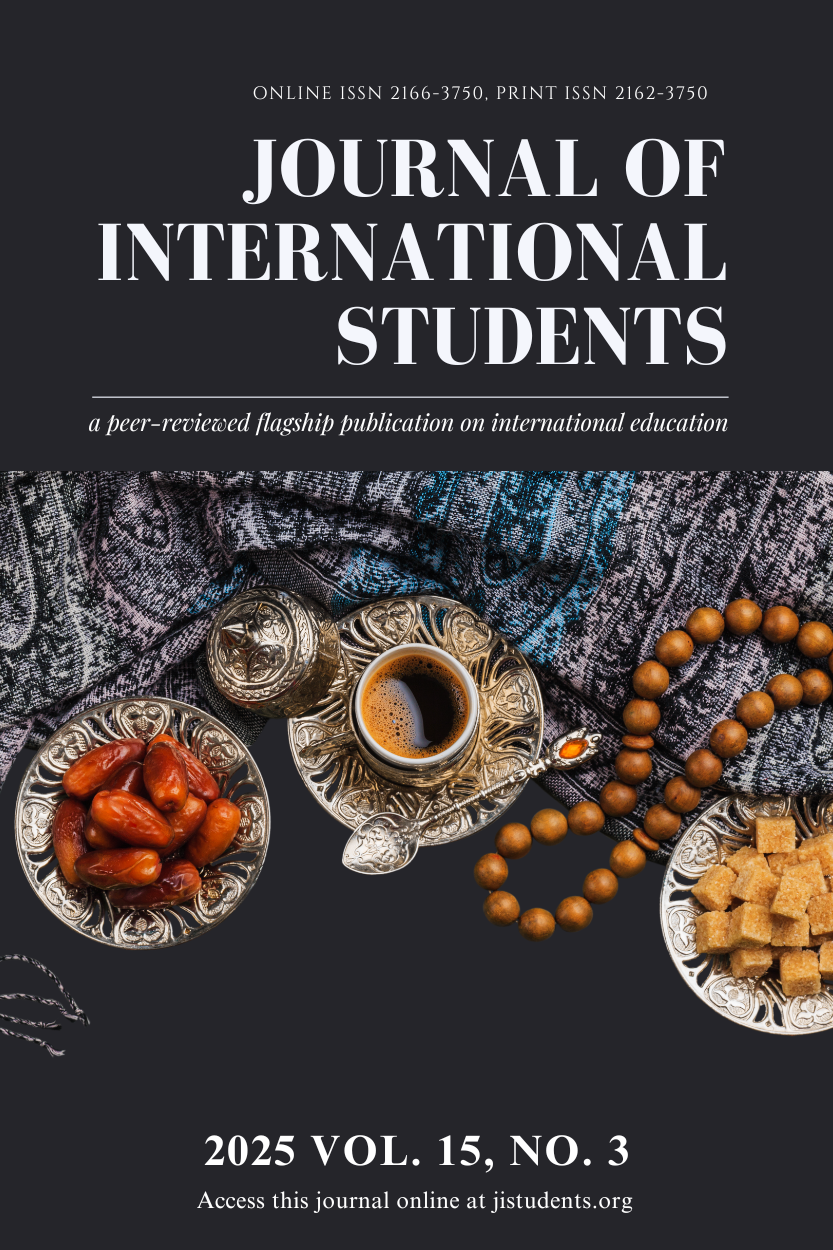Examining language anxiety and academic success of Saudi international students in U.S. colleges
DOI:
https://doi.org/10.32674/8cf0b460Keywords:
Language Anxiety and Academic SuccessAbstract
This study examines the relationship between academic performance (GPA), Foreign Language Classroom Anxiety (FLCA), and English proficiency (IELTS scores) among Saudi international students in the United States while considering demographic factors such as gender, age, college major, and length of U.S. residency. Data from 551 students, collected via an online survey, reveal a moderate negative relationship between FLCA and GPA but no significant correlation between IELTS scores and GPA. Regression analysis identifies key predictors of academic performance, including low FLCA levels, college majors, and earning a master’s degree in English-speaking countries. The findings emphasize the importance of addressing language anxiety and demographic diversity to enhance academic success for Saudi students in U.S. colleges.
References
Al-Shehri, M., & Al-Qahtani, H. (2024). Saudi students’ reluctance to engage in English communication: Critical issues and considerations. International Journal of Learning, Teaching and Educational Research, 23(2), 101–115. https://www.ijlter.org/index.php/ijlter/article/view/10109
Ahmed, R., & Saleh, T. (2024). A study of English language learning anxiety and teaching strategies. Arab World English Journal, 15(1), 250–266. https://awej.org/wp-content/uploads/2024/06/25.pdf
Aida, Y. (1994). Examination of Horwitz, Horwitz, and Cope’s construct of foreign language anxiety: The case of students of Japanese. The Modern Language Journal, 78(2), 155–168. https://doi.org/10.2307/329005 DOI: https://doi.org/10.1111/j.1540-4781.1994.tb02026.x
Al-Asiri, E. (2019). The impact of language barriers on Saudi students’ academic achievement in the U.S. Journal of International Education Research, 15(1), 35–48. https://doi.org/10.19030/jier.v15i1.10200
Alghamdi, S. (2024). Understanding English language anxiety among undergraduate Saudi EFL learners: The case of Business College, PSAU. Journal of English Language Studies, 12(3), 301–318.
Alghamdi, A. (2020). Saudi students in the U.S.: English proficiency and academic challenges. International Journal of Educational Research, 102, 101-109. https://doi.org/10.1016/j.ijer.2020.101109
Alharbi, F., & Bukhari, S. (2024). Exploring the phenomenon of foreign language speaking anxiety among English language learners in Saudi Arabia. Theory and Practice in Language Studies, 14(1), 45–60. DOI: https://doi.org/10.17507/tpls.1405.09
https://tpls.academypublication.com/index.php/tpls/article/view/8152
Al-Krenawi, A., Graham, J. R., & Sehwail, M. A. (2020). Academic performance and social adjustment among Saudi students. The International Journal of Social Psychiatry, 66(2), 179–187.
https://doi.org/10.1177/0020764019877890
Alrabai, F. (2017). The influence of foreign language anxiety on language learning in Saudi Arabia. International Journal of Education and Development using ICT, 13(1), 101-119. Retrieved from https://ijedict.dec.uwi.edu/ DOI: https://doi.org/10.4324/9781315688466-5
Al-Shboul, M. (2013). Challenges of international students in U.S. colleges. Journal of International Students, 3(2), 184–191.
https://doi.org/10.32674/jis.v3i2.520
Barnawi, O. Z. (2009). International Saudi students’ learning experiences in higher education. Learning and Teaching, 2(2), 81–98. https://doi.org/10.3167/latiss.2009.020205 DOI: https://doi.org/10.3167/latiss.2009.020205
Bailey, M. J., & DiPrete, T. A. (2016). The role of education and family background in socioeconomic success. Social Forces, 95(1), 61–88. https://doi.org/10.1093/sf/sow074 DOI: https://doi.org/10.1093/sf/sow074
Basfar, K., & Alotaibi, M. (2024). Triggers for foreign language speaking anxiety: Perceptions of Saudi EFL college students. English Language Teaching, 17(4), 134–149. DOI: https://doi.org/10.5539/elt.v17n2p1
Caskie, G. I., Sutton, M. C., & Eckhardt, A. G. (2014). Adjustment and academic success in international students. International Journal of Psychology, 49(3), 242–249. https://doi.org/10.1002/ijop.12040 DOI: https://doi.org/10.1002/ijop.12040
Curtin, J. (2019). The role of English proficiency tests in international student success. Language Testing, 36(4), 513–531.
https://doi.org/10.1177/0265532219826222
Doğan, Y., & Tuncer, M. (2016). The impact of foreign language anxiety on academic achievement. Procedia - Social and Behavioral Sciences, 232, 392–400. https://doi.org/10.1016/j.sbspro.2016.10.054 DOI: https://doi.org/10.1016/j.sbspro.2016.10.054
Halder, U. (2018). Language proficiency and its role in academic achievement. International Journal of Applied Linguistics, 28(3), 305–320.
https://doi.org/10.1111/ijal.12185 DOI: https://doi.org/10.1111/ijal.12185
Horwitz, E. K. (2000). Foreign and second language anxiety. Language Teaching, 33(3), 275–289. https://doi.org/10.1017/S026144480001588X
Horwitz, E. K. (2016). Reflections on foreign language anxiety research. Language Learning, 66(1), 1–12. https://doi.org/10.1111/lang.12135 DOI: https://doi.org/10.1111/lang.12135
Kuh, G. D., Kinzie, J., Schuh, J. H., & Whitt, E. J. (2006). Student success in college: Creating conditions that matter. Jossey-Bass.
Marcos-Llinás, M., & Garau, M. J. (2009). Effects of anxiety on foreign language learners in U.S. classrooms. System, 37(4), 621–635.
https://doi.org/10.1016/j.system.2009.09.005 DOI: https://doi.org/10.1016/j.system.2009.09.005
Martirosyan, N. M., Hwang, E., & Wanjohi, R. (2015). Academic performance predictors for international students. Journal of International Students, 5(1), 50–61. https://doi.org/10.32674/jis.v5i1.440 DOI: https://doi.org/10.32674/jis.v5i1.443
Nagahashi, T. L. (2007). Techniques to reduce language anxiety. Asian EFL Journal, 9(2), 101–118. Retrieved from https://www.asian-efl-journal.com/
Onwuegbuzie, A. J., Bailey, P., & Daley, C. E. (1999). Factors associated with foreign language anxiety. Applied Psycholinguistics, 20(2), 217–239. https://doi.org/10.1017/S0142716499002030 DOI: https://doi.org/10.1017/S0142716499002039
Open Doors Report. (2024). International educational exchange. Institute of International Education. Retrieved from https://opendoors.iie.org/
Razak, N. A., Yassin, S. M., & Maasum, T. N. R. T. (2017). Foreign language anxiety in academic settings. English Language Teaching, 10(4), 95–103. https://doi.org/10.5539/elt.v10n4p95 DOI: https://doi.org/10.5539/elt.v10n2p73
Roy, A., & Luo, Y. (2020). International student trends in U.S. higher education. Higher Education, 80(4), 1–10. https://doi.org/10.1007/s10734-020-00502-5
Song, Y. (2019). Academic English and language anxiety. English for Academic Purposes, 14(3), 198–214. https://doi.org/10.1016/j.jeap.2019.03.004 DOI: https://doi.org/10.1016/j.jeap.2019.03.004
Strayhorn, T. L. (2007). Factors influencing international students' academic performance. NASPA Journal, 44(3), 415–435.
https://doi.org/10.2202/0027-6014.1804
Taylor, M. J., & Albasri, W. A. (2014). Saudi students and the King Abdullah Scholarship Program. International Journal of Education, 6(1), 70–84. https://doi.org/10.5296/ije.v6i1.4492
Woodrow, L. (2006). Anxiety and speaking proficiency in ESL. System, 34(3), 308–321. https://doi.org/10.1016/j.system.2006.04.002 DOI: https://doi.org/10.1016/j.system.2006.04.002
Zwick, R. (2012). Fairness in international student testing. Educational Measurement, 31(2), 12–20. https://doi.org/10.1111/emip.2022.00349
Downloads
Published
Issue
Section
Categories
License
Copyright (c) 2025 Journal of International Students

This work is licensed under a Creative Commons Attribution-NonCommercial-NoDerivatives 4.0 International License.
All published articles are licensed under a Creative Commons Attribution-NonCommercial-NoDerivs 4.0 Unported License.















